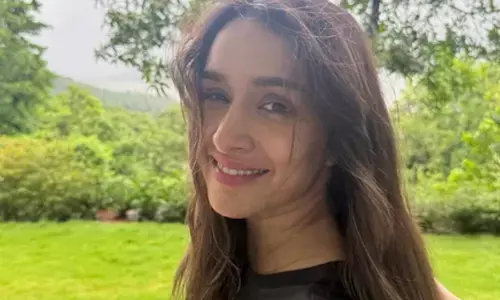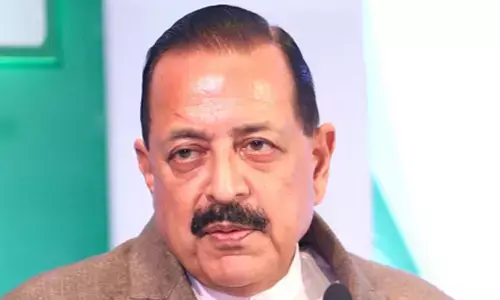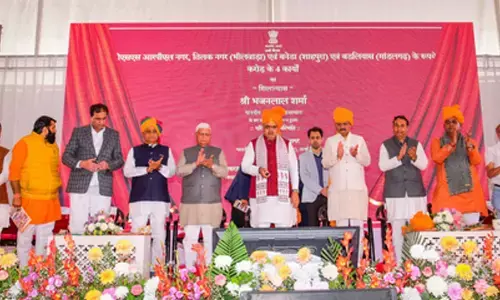SC verdict: Criminalisation of sex with minor brides

On October 17, the Supreme Court read down the marital rape exception for married girls between the ages of 15 and 18.
On October 17, the Supreme Court read down the marital rape exception for married girls between the ages of 15 and 18.
S The judgment is prospective in nature.
S The court held that since sexual assault in marriage is already a crime under the Protection of Children from Sexual Offences Act, 2012 (POCSO), it is discriminatory and arbitrary to suspend the protection of the rape law for these underage married girls.
S A girl child below the age of 18 cannot be treated as a commodity having no say over her body or someone who has no right to deny sexual intercourse to her husband.
S The harsh reality is that most of the child brides are even below the age of 15 years. There is a practice in many parts of the country where children, both girls and boys, are married off, even before they attain puberty. They are innocent children, who do not even understand what marriage is.
S By ruling that marriage cannot be a license to have sex with a minor girl, the Supreme Court has corrected an anomaly in the country’s criminal law.
Laws of the land for the
rescue of girl child
1. The Prohibition of Child Marriage Act of 2006
The Prohibition of Child Marriage Act, 2006prohibits the validation of child marriages wherein a child means a person who if male has not yet completed 21 years, and if female not yet 18 years.
Every child marriage, whether solemnized before or after the Act came into effect, can be made void by either the man or the woman within two years of attaining majority.
Karnataka has passed a law making all child marriages void.
1. Protection of Children from
Sexual Offences Act
S POCSO privileges age to define to a child, wherein consent of a child is not a defence to sexual assault.
Sexual consent is defined as an adult category.
Hence, the argument that marriage presumes consent is not acceptable in the law on sexual assault of children.
POCSO defines a child, (irrespective of gender) as a person under the age of 18 years, which prevents the “inducement or coercion of a child to engage in any unlawful sexual activity”.
It mandates the Central and State governments to take all measures to ensure publicity to the provisions of the Act and obliges government officials to be trained in how to implement the Act.
The brief of any government is to act to secure the best interests of the child since the Indian state acceded in 1992 to the UN General Assembly’s Convention on the Rights of the Child.
What different personal laws are saying?
The discrepancies in personal laws are greater. Under the Hindu Marriage Act, 1955, (applicable to Hindus, Buddhists, Sikhs, Jains) and the Dissolution of Muslim Marriages Act, 1939, a girl can legally seek dissolution of her marriage if she was married off before the age of 15 years — but she has to do so before she is 18 years of age (unlike the PCMA which sets the age at 20 for girls and 22 for boys). The uncodified Muslim personal law considers puberty (presumed to be 15 years) as the minimum age of marriage for girls. The Hindu Marriage Act, while making the marriage of an under-18 girl punishable, applies the punitive measures only against the boy who is over 18 years of age, and not against the parents or guardians.
The Indian Christian Marriage Act also in a way legitimises child marriage by stating that marriage registrars have to put up a public notice for 14 days prior to the marriage of a minor.
Child marriage in India
S Child marriage has historically cast a shadow over rape law reform in India. Child marriage is a specific form of customary practice arranged by parents or male community elders.
S These are a distinct form of early marriages in which the consent of the patriarch of the family or elder determines the matrimonial fate of the child.
S Recently, research by Young Lives in coordination with National Commission for Protection of Child Rights (NCPCR) revealed that Rajasthan has reported the highest incidence of child marriages.
Highlights of the report
S The study based on 2011 Census, stated that 2.5% of marriages of minor girls were reported in Rajasthan.
S The other states with a high incidence of marriages of girls below the legal age are Meghalaya, Arunachal Pradesh, Bihar, Uttar Pradesh, Gujarat, Sikkim, Madhya Pradesh and West Bengal.
S Rajasthan also topped in the percentage of boys marrying below the legal age of 21 (4.69%).
S However, the incidence of child marriage among girls increased substantially in urban India from 1.78% in 2001 to 2.45% in 2011.
Major reasons for prevalence of
child marriage in India
Economies of marriage
S Poverty and marriage expenses such as dowry may lead a family to marry off their daughter at a young age to reduce these costs.
S Patriarchal Indian society considers a girl as an economic burden. Marrying her off at an early age is a way to transfer this burden to the marital family.
Lack of education
S Poor educational opportunities for girls, especially in rural areas increase the vulnerability of a girl child to be married off early.
S Also, in the current patriarchal setup of the Indian society a girl’s right to education is regarded as a secondary priority to her labour in the household. This aggravates the situation as the girl’s’ power to resist marriage and opt for alternative aspirations is decreased.
S Patriarchy and gender inequalities prevailing in the Indian society is one of the major reasons for persisting high incidence of child marriages.
Impacts of child marriage on women’s health: Issues related to early pregnancy. Mental health is also a major concern. Violence and abuse at marital home can lead to post-traumatic stress and depression.
On education: Girls are forced to drop out schools. There lies a cause and effect relationship between lack of education and child marriage.
On Fertility: Lower age at marriage directly affects fertility rates. Lower the rate of age at marriage higher is the fertility rate.
Maternal mortality: Maternal mortality is high among women who have conceived at an early age. Risks associated with pregnancy are higher.
Infant mortality: Mortality rates of children born to very young mothers are high. The children that survive are likely to develop health problems and are more at risk of transmitting HIV/AIDS.
Violation of rights of children: The Rights of Children are denied by early marriage. The Convention on the Rights of the Child is designed to guarantee certain individual rights.
Child marriage denies the following rights
S The right to education,
S The right to be protected from physical and mental violence, injury or abuse, including sexual abuse, rape and sexual exploitation,
S The right to the enjoyment of the highest attainable standard of health·
S The right to rest and leisure, and to participate freely in cultural life,
S The right to not be separated from parents against the child’s will,
S The right to protection against all forms of exploitation affecting any aspect of the child’s welfare and
S The right to eventual employment
How to annul child
marriage under PCMA
The Prohibition of Child Marriage Act, 2006 prohibits the solemnisation (the celebration of marriage) of child marriages wherein a child means a person who if male has not yet completed 21 years, and if female not yet 18 years.
As marriages in India come under the purview of personal laws, the PCMA stops short of invalidating child marriage. It holds that marriage between a boy of under 21 years and a girl under 18 years of age is voidable, at the option of the contracting parties.
Further, every child marriage, whether solemnised before or after the Act came into effect, can be made void by either the man or the womanwithin two years of attaining majority. Karnataka has passed a law making all child marriages void.
This means a child marriage, even under the secular laws, can only be annulled if a case is filed in a district court by either of the two contracting parties within two years of becoming adult, or through a guardian if still a minor.
Personal laws vs PCMA
While the PCMA overrides personal laws, it has been argued that personal laws should be amended to make them consistent with PCMA. This is in the light of court judgments such as Tahra Begum vs State Of Delhi and Ors (2012), wherein Delhi High Court allowed a 15-year-old Muslim girl to stay with her husband.
What official statistics are saying
The Child Marriage Restraint Act, 1929, was amended to create the PCMA in 2006, introducing more stringent punishments, including a jail term of up to two years for the 18-years-plus boy or anyone who abets/performs such a marriage. Yet, the National Family Health Survey 4 (2015-16) showed that one out of every four women (26.8%) aged 20-24 years was married off as a minor — the prevalence in Rajasthan was as high as 65%, followed by Jharkhand at 63%.
Evidence for the inefficacy of the PCMA lies in National Crime Records Bureau (NCRB) data. In 2014, 2015 and 2016, only 280, 293, and 326 cases respectively were registered under the Act. Rajasthan registered only 5, 6, and 12 cases under PCMA in these three years, while Jharkhand saw 4 cases being registered last year and just one each in the preceding two.
Decadal data, too, show no reduction in the incidence of child marriage. The country’s apex child rights’ body, the National Commission for Protection of Child Rights (NCPCR), and the NGO Young Lives used Census 2011 data to bring out a report on the incidence of child marriage in June 2017. The report showed that in 2011, 5.16 million girls were married before the age of 18 years — virtually the same as in 2001, when this figure was 5.05 million.
A 2014 UNICEF report, which ranked India 6th among the top 10 countries with high rates of child marriage among women, found that the median age at first marriage was 15.4 years for women in the poorest quintile, and 19.7 years for those in the richest quintile.
Reasons behind child marriages
S Child marriage is a specific form of customary practice arranged by parents or male community elders. These may be community marriages dictated by religious calendars or by caste customs. These are a distinct form of early marriages in which the consent of the patriarch of the family or elder determines the matrimonial fate of the child.
S The second species of marriage is found in different customary and personal laws wherein the age at which a girl can be married is lower than the legal age of marriage. The impetus for early marriages, across customary or personal laws, is to prevent young girls from falling in love and experimenting with illicit sex, which is seen to bring dishonour to male defined communities.
What is the age of consent
S There are two broad responses to the age of consent. The first perspective that evokes the political economy of custom and law argues for a lowering of age of consent to 16. This, however, creates a conflict with the definition of the child under POCSO, unnecessarily pitting women’s rights against child rights.
S The second stance recommends a proximity in age clause in the age of consent provision to prevent the criminalisation of young people who are sexually active between 16 to 18 years, thereby suggesting a limited form of legal exceptionalism in the best interest of the child.
S A 2008 Law Commission Report recommended compulsory registration of all marriages, and for keeping the age of marriage for both boys and girls at 18 years, breaking with the current “patriarchal notion” that mandates an older age of 21 for the groom. The Law panel also said that marriages below the age of 16 years should be made void, while keeping those between 16 and 18 voidable, provided the age of consent is reduced to 16 years for all girls.
The Justice Verma Committee, set up in the wake of the December 2012 Delhi bus gangrape, too, had asked that the age of consent be kept at 16 years.
Individual choice is independent
The question of sexual consent is clearly one that must lie with the individual woman. Parents, elders, political parties, priests or vigilante groups should not be permitted to force women, adult or minor, into marriage or compulsory heterosexuality. This also means that young adults should not be forced into heterosexuality per se, if they are not sexually attracted to the opposite sex.
The Supreme Court rightly holds that the ‘the girl child must not be deprived of her right of choice’. The right to choose, which is free and unfettered, includes freedom from parental pressure to marry early, freedom from forced marriages, freedom of choice of sexual orientation, and freedom to find self-fulfilment through study, work, profession, vocation or talent.
Why is child marriages
still practiced in India?
Child marriage is a specific form of customary practice arranged by parents or male community elders. These may be community marriages dictated by religious calendars or by caste customs.
These are a distinct form of early marriages in which the consent of the patriarch of the family or elder determines the matrimonial fate of the child. Different customary and personal laws are existed wherein the age at which a girl can be married is lower than the legal age of marriage. Feminists critiqued the prevailing conditions for Girl child.
Feminists have critiqued the custodial violence of the family and the state towards women who marry of choice.
They have protested against familial and state violence towards daughters. At the same time, feminists have also insisted on bringing to the law recognition of sexual assault of children,irrespective of gender.
They have also gendered the notion of childhood. Feminists have also elaborated how adolescence is gendered.
What is the conflict between
IPC 375 and POCSO Act?
Till now sexual intercourse with minor wife did not amount to rape if she was over 15 years of age. This was in the Indian Penal code (IPC) as an exception to Section 375 which is the law of the land regarding Rape.
This exception meant that the husband was not charged with Rape even though child marriage is a crime. Hence under previous exception minor girl’s husband can have non-consensual sexual intercourse with her, without being penalised under the IPC, simply because she is married to him and for no other reason.
This came into conflict with 2012 POCSO (Protection of Children from sexual offences) Act that defines ‘children’ as those aged below 18.
In a land mark judgement SC on October 11, 2017 criminalised the sex with wife aged between 15 and 18 years.
Why does the SC judgement a major relief to the child bride?
Though child marriage is prohibited, it is not automatically void under India’s civil laws. The court criticised the fact that PCMA (Prohibition of Child Marriage Act of 2006) makes child marriage only voidable, that is, the burden is placed on the child bride to approach a court to declare her marriage a nullity. She has to do this within two years of attaining majority that is by the time she is 20 years old. If not, the marriage continues.
The judgement is a major relief to the child bride because an unmarried girl child can prosecute her rapist, but a married girl child aged between 15 and 18 could not even do that due to the exception given to the Section 375, IPC.
What is the government’s
stand on this issue?
The court slammed the government for trying to “somehow legitimise” the exception clause.


















